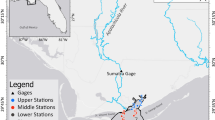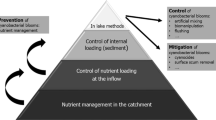Abstract
Risk based management of aquatic resources for ecosystem and public health requires water managers and health professionals to work together. Using an epidemiologic time-series modelling approach, we assess patterns of risk for alert-level cyanobacterial abundance with water temperature. We focus on six sites along the Murray–Darling Drainage Basin, using the longest continuous record of algal abundance in Australia. Alert-level cyanobacterial abundance showed a non-linear and lagged response to water temperature across all six sites, after controlling for relative water discharge. For three sites there was a positive relationship of high-water temperature with the risk of alert-level abundance. These three sites also showed a substantial lagged effect, with the risk remaining high at a lag of 1 month following high water temperatures. The higher than average risk of alert-level cyanobacterial abundance with extreme water temperature and the persistence of this effect for 1 month highlight the applicability of these models to understand non-linear and time-dependent relationships in complex systems which are managed for ecosystem and population health. The site-specific relationships provide guidance for local authorities to develop water quality-related environmental and public health responses to a variable climate.






Similar content being viewed by others
References
Bowling L, Egan S, Holliday J, Honeyman G (2016) Did spatial and temporal variations in water quality influence cyanobacterial abundance, community composition and cell size in the Murray River, Australia during a drought-affected low-flow summer? Hydrobiologia 765(1):359–377
Brooks BW, Lazorchak JM, Howard MD, Johnson MVV, Morton SL, Perkins DA, Reavie ED, Scott GI, Smith SA, Steevens JA (2016) Are harmful algal blooms becoming the greatest inland water quality threat to public health and aquatic ecosystems? Environ Toxicol Chem 35(1):6–13
Cha Y, Cho KH, Lee H, Kang T, Kim JH (2017) The relative importance of water temperature and residence time in predicting cyanobacteria abundance in regulated rivers. Water Res 124:11–19
Chancey C, Grinev A, Volkova E, Rios M (2015) The global ecology and epidemiology of West Nile virus. Bio Med Res Int. https://doi.org/10.1155/2015/376230
DPI N (2019) Fish death interim investigation report, Lower Darling River Fish Death Event, Menindee 2018/19. N. D. o. P. Industries
Gasparrini A, Armstrong B (2011) Distributed lag non-linear models in R: the package dlnm
Gasparrini A, Armstrong B, Kenward MG (2010) Distributed lag non-linear models. Stat Med 29(21):2224–2234
Hall NL, Ross H, Richards R, Barrington DJ, Dean AJ, Head BW, Jagals P, Reid S, Hill PS (2018) Implementing the United Nations’ sustainable development goals for water and beyond in Australia: a proposed systems approach. Australas J Water Res 22(1):29–38
Havens KE, Ji G, Beaver JR, Fulton RS, Teacher CE (2019) Dynamics of cyanobacteria blooms are linked to the hydrology of shallow Florida lakes and provide insight into possible impacts of climate change. Hydrobiologia 829(1):43–59
Hofer U (2018) Marine microbiology: climate change boosts cyanobacteria. Nat Rev Microbiol 16(3):122
Huisman J, Codd GA, Paerl HW, Ibelings BW, Verspagen JM, Visser PM (2018) Cyanobacterial blooms. Nat Rev Microbiol 16(8):471
Liu D, Xu Y, Guo S, Xiong L, Liu P, Zhao Q (2018) Stream temperature response to climate change and water diversion activities. Stoch Env Res Risk Assess 32(5):1397–1413
Maier HR, Dandy GC, Burch MD (1998) Use of artificial neural networks for modelling cyanobacteria Anabaena spp. in the River Murray, South Australia. Ecol Model 105(2–3):257–272
Murray Darling Basin Authority (2017) Disover the basin
Schotthoefer AM, Frost HM (2015) Ecology and epidemiology of Lyme borreliosis. Clin Lab Med 35(4):723–743
Soranno P, Hubler S, Carpenter S, Lathrop R (1996) Phosphorus loads to surface waters: a simple model to account for spatial pattern of land use. Ecol Appl 6(3):865–878
Tamerius JD, Wise EK, Uejio CK, McCoy AL, Comrie AC (2007) Climate and human health: synthesizing environmental complexity and uncertainty. Stoch Env Res Risk Assess 21(5):601–613
Walls JT, Wyatt KH, Doll JC, Rubenstein EM, Rober AR (2018) Hot and toxic: temperature regulates microcystin release from cyanobacteria. Sci Total Environ 610:786–795
Wilson ML, Krogstad DJ, Arinaitwe E, Arevalo-Herrera M, Chery L, Ferreira MU, Ndiaye D, Mathanga DP, Eapen A (2015) Urban malaria: understanding its epidemiology, ecology, and transmission across seven diverse ICEMR network sites. Am J Tropical Med Hyg 93((3_Suppl)):110–123
Woodhouse JN, Kinsela AS, Collins RN, Bowling LC, Honeyman GL, Holliday JK, Neilan BA (2016) Microbial communities reflect temporal changes in cyanobacterial composition in a shallow ephemeral freshwater lake. ISME J 10(6):1337
Xiao R, Su S, Ghadouani A, Wu J (2013) Spatial analysis of phytoplankton patterns in relation to environmental factors across the southern Taihu basin, China. Stoch Env Res Risk Assess 27(6):1347–1357
Author information
Authors and Affiliations
Contributions
A.L conceptualised this work and carried out the analysis. A.L and J.H wrote and reviewed the manuscript.
Corresponding author
Ethics declarations
Conflict of interest
The authors declare no competing interests.
Additional information
Publisher's Note
Springer Nature remains neutral with regard to jurisdictional claims in published maps and institutional affiliations.
Electronic supplementary material
Below is the link to the electronic supplementary material.
Rights and permissions
About this article
Cite this article
Lal, A., Hargreaves, J. An epidemiologic approach to environmental monitoring: cyanobacteria in Australia’s Murray–Darling basin. Stoch Environ Res Risk Assess 34, 949–958 (2020). https://doi.org/10.1007/s00477-020-01811-2
Published:
Issue Date:
DOI: https://doi.org/10.1007/s00477-020-01811-2




